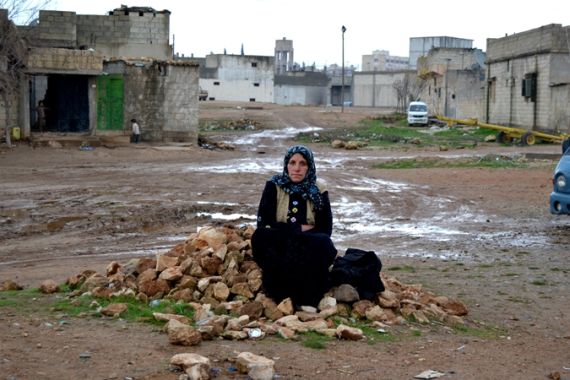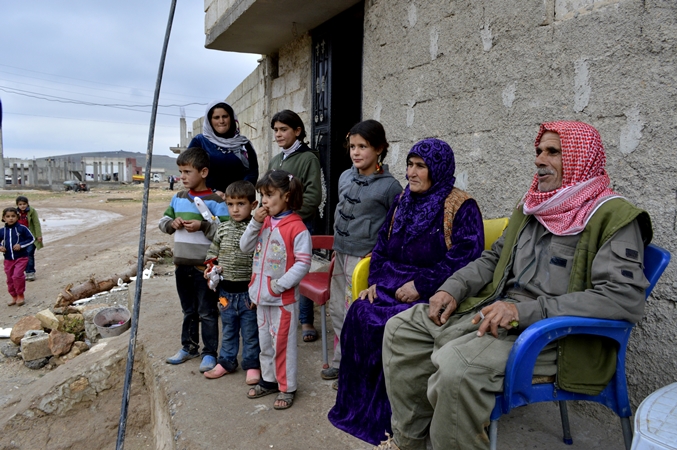Inside Kobane: United against ISIL
Kobane’s remaining civilians explain why they chose to stay behind despite the risks.

Kobane – On a chilly December afternoon, 30-year-old Letfiya Aberkali Zelema is huddled around a small campfire outside her home in western Kobane. “We have no heat and no fuel,” she explains. “We have to make fires outside and cook here.”
Letfiya is one of hundreds of civilians still living in Kobane, despite three months of intense fighting against ISIL fighters and an almost two-year-long siege of the city.
While thousands of other civilians fled across the border to Turkey when the fighting started, Letfiya’s family decided to stay.
“We don’t want to leave,” she says. “What would we do in another country? In Turkey they treated us like gypsies. This is our land. Why should we leave it for others? It’s better to die here.”
Although there are no shops left in the town, YPG and Peshmerga fighters, in coordination with the local authority, run by the Syrian Kurdish Democratic Union Party, or PYD, organise regular distributions of basic supplies to all local residents, including food, clothes and medicine.
Even garbage collection continues, the garbage man tossing bags into the back of a small truck, shovel in one hand and a rifle strapped to his back.
RELATED: Fighting rages for control of Syria’s Kobane
Other than fuel, Letfiya says her biggest concern is her five children, who range in age from 18 months to 12 years old. “They are afraid. We try to tell them everything is fine but if there’s a mortar shell they get scared.”
Today, however, the children are running around a large patch of wasteland in front of the house, laughing and taking turns on a small bicycle, occasionally coming back to the fire to warm up. Even the sound of a not-so distant mortar strike doesn’t interrupt their game.
It's been three years and our people - even small children - know how to fight. Everyone has learned how to use a weapon.
“Somehow we’re used to it now,” Letfiya says. “This has been our life for months.”
While Letfiya spends her days taking care of her family, most civilians are actively participating in the war effort.
“It’s been three years and our people – even small children – know how to fight,” says 22-year-old Ahmed Ismael. “Everyone has learned how to use a weapon.”
A former carpenter, Ahmed joined YPG four months ago.
Based in a small house in the now destroyed market area of Kobane, he helps provide support to the frontline, bringing food and ammunition to fighters or transporting injured soldiers to hospital.
YPG fighters have knocked down walls between the terraced houses and shops so they can cross the town under safe cover of the buildings, while large sheets are hung across the entrance of some streets to protect them from ISIL snipers in the distance.
“We are fighting for the sake of our freedom,” he says. “We are fighting so that our lives could go back to normal again.”
Backed by coalition air strikes, Kurdish fighters are making progress against ISIL and have reclaimed 70 percent of the town, according to Kobane Defence Minister Ismat Sheikh Hassan.
Although Kurdish officials in Kobane claim they now control 70 percent of the town, a claim that could not be verified independently, ISIL fighters are still in charge of the bulk of broader Kobane area which includes approximately 400 villages.
There is still a long fight ahead, warns Anwar Muslim, head of the local government in Kobane.
“It’s not going to be easy because even if we push ISIL out of Kobane, we will still be surrounded by them,” he told Al Jazeera, as he occasionally monitors the messages from a walkie-talkie device hanging overhead on a wall. “We will need a [humanitarian] corridor to the outside world [to survive].”
 |
| Families that have made the choice to stay in Kobane are facing an uncertain future [Mohammed Salih/Al Jazeera] |
In the meantime, residents are adapting to life under siege, united in their determination to survive and protect their town.
Amish Ahmed, 55, and her husband are sitting on plastic chairs in front of their son’s house in Kobane, surrounded by children and grandchildren.
If it weren’t for the occasional boom sound of rockets and gunfire, this scene could be anywhere.
“Women who can fight are fighting and others are at home,” says Amish, whose wrinkled skin testifies to the rough life she has had. “We make bread for the fighters.”
The children are clearly affected by the conflict, as can be seen by their muddy clothes and a little boy who wields a plastic toy gun and pretends to be shooting at his sister.
Amish and her husband, Aladdin Abdo, used to live in the nearby village of Ziravuk before ISIL forces swept into their area.
Aladdin says the villagers fought for almost four days before deciding it was too unsafe to stay. Part of the family went to Turkey but the couple, and some of their children, decided to stay.
Those like this family, who have made the choice to stay in Kobane, are facing an uncertain future.
“We are used to this situation here, the fighting and the shelling,” says Aladdin, who has now joined the resistance and is wearing the Kurdish fighters’ signature gray fatigues.
“Kobane has resisted for 90 days. We have stood before their heavy weapons and have fought with our own limited means and power. We want nothing but victory and we’ll achieve it.”